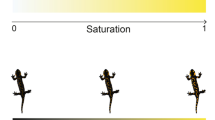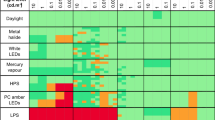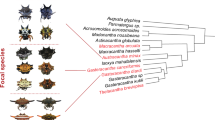Abstract
Boundaries of species distributions are the result of colonization-extinction processes. Survival on the boundary depends on how well individuals discriminate optimal from suboptimal habitat patches. Such behaviour is called habitat choice and was only rarely applied to macroecology, although it links species ecological niche and species distribution. Surface and subterranean aquatic species are spatially strongly segregated, even in the absence of physical barriers. We explored whether a behavioural response to light functions as a habitat choice mechanism that could explain species turnover between surface and subterranean aquatic ecosystems. In a controlled laboratory experiment, we studied the behavioural response to light of ten pairs of surface and subterranean amphipods that permanently co-occur in springs. Surface species showed a weak photophobic, photoneutral, and in one case, photophilic response, whereas all subterranean species showed a strong photophobic response. Eyeless subterranean but not eyed surface amphipods appear to orient themselves with light cues. On a local scale, this difference possibly diminishes harmful interactions between the co-occurring amphipods, whereas on a regional scale, photophobia could explain limited dispersal and a high degree of endemism observed among subterranean species.




Similar content being viewed by others
References
Åbjörnsson K, Hansson LA, Brönmark C (2004) Responses of prey from habitats with different predator regimes: local adaptation and heritability. Ecology 85:1859–1866
Aspiras AC, Rohner N, Martineau B et al (2015) Melanocortin 4 receptor mutations contribute to the adaptation of cavefish to nutrient-poor conditions. Proc Natl Acad Sci 112:9668–9673
Bartoń K (2014) MuMIn: multi-model inference. R package version 1(10):5, http://cran.r-project.org/package=MuMIn
Bates D, Maechler M, Bolker B, Walker S (2014) lme4: linear mixed-effects models using Eigen and S4. R package version 1:1–7, http://cran.r-project.org/package=lme4
Binckley C, Resetarits WJ (2005) Habitat selection determines abundance, richness and species composition of beetles in aquatic communities. Biol Lett 1:370–374
Borowsky B (2011) Responses to light in two eyeless cave dwelling amphipods (Niphargus ictus and Niphargus frasassianus). J Crustac Biol 31:613–616
Buckley LB, Jetz W (2008) Linking global turnover of species and environments. Proc Natl Acad Sci U S A 105:17836–17841
Carroll TM, Thorp JH (2014) Ecotonal shifts in diversity and functional traits in zoobenthic communities of karst springs. Hydrobiologia 738:1–20
Cézilly F, Favrat A, Perrot-Minnot M-J (2013) Multidimensionality in parasite-induced phenotypic alterations: ultimate versus proximate aspects. J Exp Biol 216:27–35
Connell JH (1961) The influence of interspecific competition and other factors on the distribution of the barnacle Chtalamus stellatus. Ecology 42:710–723
Culver DC, Pipan T (2009) The Biology of Caves and Other Subterranean Habitats Oxford University Press, New York, USA.
Culver DC, Pipan T (2014) Shallow Subterranean Habitats. Ecology, Evolution and Conservation. Oxford University Press, New York, USA
Dianne L, Perrot-Minnot M-J, Bauer A et al (2011) Protection first then facilitation: a manipulative parasite modulates the vulnerability to predation of its intermediate host according to its own developmental stage. Evolution 65:2692–2698
Edelaar P, Siepielski AM, Clobert J (2008) Matching habitat choice causes directed gene flow: a neglected dimension in evolution and ecology. Evolution 62:2462–2472
Elliott JM (2005) Day-night changes in the spatial distribution and habitat preferences of freshwater shrimps, Gammarus pulex, in a stony stream. Freshw Biol 50:552–566
Fišer C, Keber R, Kereži V et al (2007) Coexistence of species of two amphipod genera: Niphargus timavi (Niphargidae) and Gammarus fossarum (Gammaridae). J Nat Hist 41:2641–2651
Fišer C, Pipan T, Culver DC (2014) The vertical extent of groundwater metazoans: an ecological and evolutionary perspective. Bioscience 64:971–979
Friedrich M (2013) Biological clocks and visual systems in cave-adapted animals at the dawn of speleogenomics. Integr Comp Biol 53:50–67
Friedrich M, Chen R, Daines B et al (2011) Phototransduction and clock gene expression in the troglobiont beetle Ptomaphagus hirtus of Mammoth cave. J Exp Biol 214:3532–41
Ginet R (1960) Écologie, éthologie et biologie de Niphargus (Amphipodes Gammaridés hypogés). Ann Spéléologie 15:127–376
Hamilton IM (2010) Habitat selection. In: Breed MD, Moore J (eds) Encyclopedia of Animal Behavior. Academic Press, pp 38–43
Holt RD, Barfield M (2008) Habitat selection and niche conservatism. Isr J Ecol Evol 54:295–309
Horstkotte J, Riesch R, Plath M, Jäger P (2010) Predation by three species of spiders on a cave fish in a Mexican sulphur cave. Bull Br Arachnol Soc 15:55–58
Hothorn T, Bretz F, Westfall P (2008) Simultaneous inference in general parametric models. Biometrical J 50:346–363
Jackson CH (2011) Multi-state models for panel data: the msm package for R. J Stat Softw 38:1–28
Johnson PCD (2014) Extension of Nakagawa & Schielzeth’s R2 GLMM to random slopes models. Methods Ecol Evol 5:944–946
Jones J (2001) Habitat selection studies in avian ecology: a critical review. Auk 118:557–562
Klaus S, Plath M (2011) Predation on a cave fish by the freshwater crab avotrichodactylus bidens (Bott, 1969) (Brachyura, Trichodactylidae) in a Mexican Sulfur Cave. Crustaceana 84:411–418
Konec M, Prevorčnik S, Sarbu SM et al (2015) Parallels between two geographically and ecologically disparate cave invasions by the same species, Asellus aquaticus (Isopoda, Crustacea). J Evol Biol 28:864–875
Kubisch A, Holt RD, Poethke HJ, Fronhofer EA (2014) Where am I and why? Synthesizing range biology and the eco-evolutionary dynamics of dispersal. Oikos 123:5–22
Kureck A (1964) Light sensitivity in the amphipode, Niphargus aquliex schellenbergi Karaman. Experientia 20:523–524
Langecker TG (1992) Light sensitivity of cave vertebrates—behavioral and morphological aspect. In: Camacho AI (ed) The natural history of biospeleology. Museo Nacional de Ciencias Naturales, Madrid, Spain, pp 296–326
Langecker TG (2000) The effects of continuous darkness on cave ecology and cavernicolous evolution. In: Wilkens H, Culver DC, Humphreys WF (eds) Ecosystems of the World 30: Subterranean Ecosystems. Elsevier, Amsterdam, The Netherlands, pp 135–157
Ludwig W (1942) Zur evolutorischen Erklärung der Höhlentiermerkmale durch Allelelimination. Biol Zent Bl 62:447–482
Luštrik R, Turjak M, Kralj-Fišer S, Fišer C (2011) Coexistence of surface and cave amphipods in an ecotone environment. Contrib to Zool 80:133–141
Malard F, Boutin C, Camacho AI et al (2009) Diversity patterns of stygobiotic crustaceans across multiple spatial scales in Europe. Freshw Biol 54:756–776
Mamos T, Wattier R, Majda A et al (2014) Morphological vs. molecular delineation of taxa across montane regions in Europe: the case study of Gammarus balcanicus Schäferna, (Crustacea: Amphipoda). J Zool Syst Evol Res 52:237–248
Marshall J, Kent J, Cronin T (1999) Visual adaptations in crustaceans: spectral sensitivity in diverse habitats. In: Archer SN, Djamgoz MBA, Loew ER et al (eds) Adaptive Mechanisms in the Ecology of Vision. Kluwer Academic Publishers, Dordrecht, The Netherlands, pp 285–327
Meleg IN, Zakšek V, Fišer C et al (2013) Can environment predict cryptic diversity? The case of Niphargus inhabiting western Carpathian groundwater. PLoS One 8, e76760
Meyer-Rochow VB (2001) The crustacean eye: dark/light adaptation, polarization sensitivity, flicker fusion frequency, and photoreceptor damage. Zool Sci 18:1175–1197
Moran D, Softley R, Warrant EJ (2014) Eyeless Mexican cavefish save energy by eliminating the circadian rhythm in metabolism. PLoS One 9:e107877
Moran D, Softley R, Warrant EJ (2015) The energetic cost of vision and the evolution of eyeless Mexican cavefish. Sci Adv 1:1–9
Morris DW (2003) Toward an ecological synthesis: a case for habitat selection. Oecologia 136:1–13
Nakagawa S, Schielzeth H (2013) A general and simple method for obtaining R2 from generalized linear mixed-effects models. Methods Ecol Evol 4:133–142
Niemiller ML, Fitzpatrick BM, Shah P et al (2012) Evidence for repeated loss of selective constraint in rhodopsin of amblyopsid cavefishes (Teleostei: Amblyopsidae). Evolution 67:732–748
Palandačić A, Matschiner M, Zupančič P, Snoj A (2012) Fish migrate underground: the example of Delminichthys adspersus (Cyprinidae). Mol Ecol 21:1658–1671
Parzefall J, Kraus C, Tobler M, Plath M (2007) Photophilic behaviour in surface- and cave-dwelling Atlantic mollies Poecilia mexicana (Poeciliidae). J Fish Biol 71:1225–1231
Passow CN, Greenway R, Arias-Rodriguez L et al (2015) Reduction of energetic demands through modification of body size and routine metabolic rates in extremophile fish. Physiol Biochem Zool 88:371–383
Pipan T, Culver DC (2012) Convergence and divergence in the subterranean realm: a reassessment. Biol J Linn Soc 107:1–14
R Core Team (2014) R: A language and environment for statistical computing. Vienna (Austria): R Foundation for Statistical Computing
Ravigné V, Olivieri I, Dieckmann U (2004) Implications of habitat choice for protected polymorphisms. Evol Ecol Res 6:125–145
Ravigné V, Dieckmann U, Olivieri I (2009) Live where you thrive: joint evolution of habitat choice and local adaptation facilitates specialization and promotes diversity. Am Nat 174:141–169
Resetarits WJ (2005) Habitat selection behaviour links local and regional scales in aquatic systems. Ecol Lett 8:480–486
Riesch R, Plath M, Schlupp I (2011) Speciation in caves: experimental evidence that permanent darkness promotes reproductive isolation. Biol Lett 7:909–912
Risser PG (1995) The status of the science examining ecotones. Bioscience 45:318–325
Rivetti C, Campos B, Barata C (2015) Low environmental levels of neuro-active pharmaceuticals alter phototactic behaviour and reproduction in Daphnia magna. Aquat Toxicol 170:289–296
Romero A, Green SM (2005) The end of regressive evolution: examining and interpreting the evidence from cave fishes. J Fish Biol 67:3–32
Simčič T, Brancelj A (2007) The effect of light on oxygen consumption in two amphipod crustaceans—the hypogean Niphargus stygius and the epigean Gammarus fossarum. Mar Freshw Behav Physiol 40:141–150
Sket B (1985) Why all cave animals do not look alike—a discussion on adaptive value of reduction processes. Bull Natl Speleol Soc 47:78–85
Sket B (2008) Can we agree on an ecological classification of subterranean animals? J Nat Hist 42:1549–1563
Stoks R, McPeek MA (2003) Antipredator behavior and physiology determine lestes species turnover along the pond permanence gradient. Ecology 84:3327–3338
Tobler M (2009) Does a predatory insect contribute to the divergence between cave- and surface-adapted fish populations? Biol Lett 5:506–9
Trontelj P, Douady CJ, Fišer C et al (2009) A molecular test for cryptic diversity in ground water: how large are the ranges of macro-stygobionts? Freshw Biol 54:727–744
van Riel MC, van der Velde G, Bij de Vaate A (2011) Dispersal of invasive species by drifting. Curr Zool 57:818–827
Vawter AT, Fong WD, Culver CD (1987) Negative phototaxis in surface and cave populations of the amphipod Gammarus minus. Stygologia 3:83–88
Weiss M, Macher JN, Seefeldt MA, Leese F (2014) Molecular evidence for further overlooked species within the Gammarus fossarum complex (Crustacea: Amphipoda). Hydrobiologia 721:165–184
White WB (2012) Springs. In: White WB, Culver DC (eds) Encyclopedia of Caves, 2nd edn. Academic Press, pp 797-805
Wickham H (2009) ggplot2 - Elegant Graphics for Data Analysis. Springer, New York, USA
Xiang Y, Yuan Q, Vogt N et al (2010) Light-avoidance-mediating photoreceptors tile the Drosophila larval body wall. Nature 468:921–926
Acknowledgments
We are grateful to Peter Trontelj, Simona Prevorčnik and Florian Malard for thoughtful discussions on experimental design and comments on early drafts of the manuscript. We also thank three anonymous reviewers for their constructive and helpful commentaries. We thank Teo Delić, Maja Zagmajster and Simona Prevorčnik for their help with fieldwork; Alenka Gaberščik and Dragan Abram for providing the Licor Li-1000 Data Logger and LI-190 Quantum Sensor; Andrej Mohar for providing the Minolta Illuminance Meter T-10; Miloš Vittori for providing the juvenile zebrafish. The project was partially supported by the Slovenian Research Agency—program P1-0184 (to ŽF and CF) and a PhD grant to ŽF.
Author information
Authors and Affiliations
Corresponding author
Additional information
Communicated by: Sven Thatje
Žiga Fišer and Luka Novak contributed equally to this work.
Electronic supplementary material
Below is the link to the electronic supplementary material.
ESM 1
(PDF 527 kb)
Rights and permissions
About this article
Cite this article
Fišer, Ž., Novak, L., Luštrik, R. et al. Light triggers habitat choice of eyeless subterranean but not of eyed surface amphipods. Sci Nat 103, 7 (2016). https://doi.org/10.1007/s00114-015-1329-9
Received:
Revised:
Accepted:
Published:
DOI: https://doi.org/10.1007/s00114-015-1329-9




